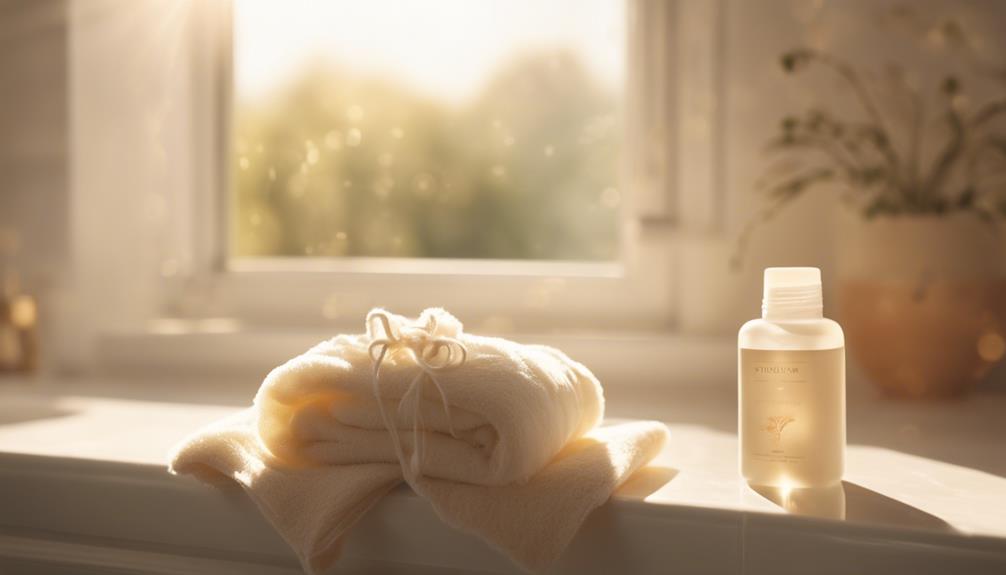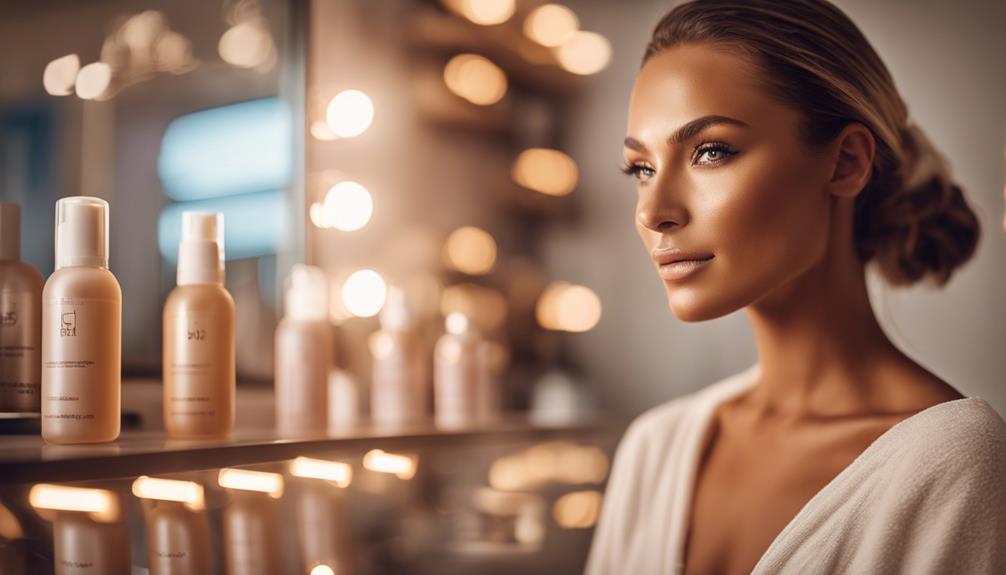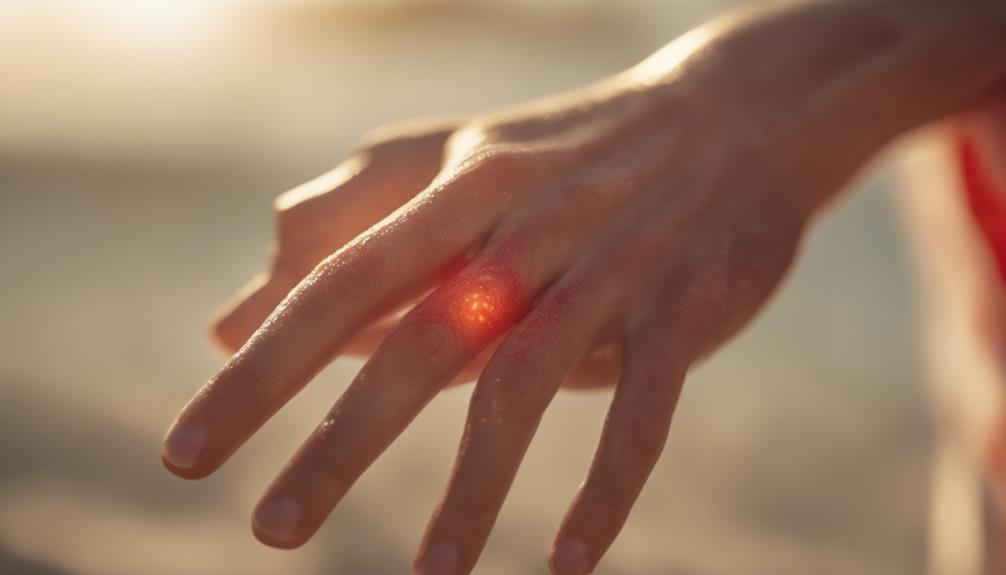To achieve a stunning sun-kissed glow today, start by choosing a tanning method that suits your skin type and desired results. Prep your skin by exfoliating and moisturizing dry areas for an even application. If you're using spray tanning, maintain a distance of 6-8 inches while applying in circular motions. Remember to avoid water for several hours after application for the best color development. Finally, keep your tan fresh by moisturizing daily and using gentle cleansers. With these steps, you'll boost your confidence and enhance your appearance. Want to uncover more tips for the perfect glow?
Key Takeaways
- Choose the right tanning method based on your skin type and desired results for a natural sun-kissed glow.
- Prepare your skin by exfoliating and moisturizing to ensure an even and smooth application.
- Use tanning mitts or sprays for a streak-free application, focusing on tricky areas like elbows and knees.
- Maintain your tan by moisturizing daily and using gentle cleansers to prevent fading and ensure longevity.
Benefits of a Sun-Kissed Glow
A sun-kissed glow not only enhances your appearance but also boosts your confidence, making you feel radiant and vibrant. It can create a healthier, more youthful look, drawing attention to your features and giving your skin a lively sheen.
This glow can also evoke feelings of happiness and positivity, making you more approachable in social settings. Additionally, a sun-kissed complexion can complement various outfits, adding an extra touch of allure to your style.
You'll notice that your self-esteem skyrockets, empowering you to embrace new experiences and connect with others effortlessly. Ultimately, achieving that coveted glow isn't just about aesthetics; it's a transformative experience that uplifts your spirit and enhances your overall presence.
Choosing the Right Tanning Method
When deciding on the best tanning method for your needs, consider factors like your skin type, desired results, and convenience.
If you have fair skin, you might prefer a gradual tanning lotion to build a subtle glow over time. For a quicker solution, spray tanning offers an even finish and customizable shades.
If you're looking for a natural sun-kissed look, consider sunless tanning products with organic ingredients. Don't forget about the application method; using a tanning mitt can help achieve a streak-free result.
Also, weigh the convenience of at-home products versus professional services. Ultimately, choose a method that fits your lifestyle and skin health, ensuring you achieve that stunning glow safely.
Preparing Your Skin for Tanning

Exfoliating your skin before tanning is essential for achieving a smooth, even application. This step removes dead skin cells, ensuring your tan looks fresh and lasts longer.
Here are some tips to prepare your skin effectively:
- Shave or Wax: Do this at least 24 hours before tanning to avoid irritation and allow your skin to settle.
- Moisturize: Use a light, oil-free moisturizer on dry areas, such as elbows and knees, to prevent uneven absorption.
Application Techniques for Best Results
Mastering application techniques is essential for achieving a flawless, streak-free tan that enhances your clients' natural beauty.
Start by practicing your spray flow and coverage to guarantee even results. Use tanning mitts to help with even application and prevent staining your hands.
Begin spraying from a distance of 6-8 inches, moving in a smooth, circular motion for consistent coverage. Pay attention to tricky areas like the elbows and knees, applying product lightly to avoid buildup.
Always keep your equipment clean to prevent clogs and maintain peak performance.
Maintaining Your Tan

To keep your spray tan looking fresh and vibrant, it's important to follow a few key maintenance steps after application.
First, avoid water for at least 6-8 hours post-tan to let the color develop fully. Once you're ready to shower, use a gentle, sulfate-free cleanser to prevent fading.
Here are some essential tips to maintain that gorgeous glow:
- Moisturize daily: Hydration helps prolong your tan; opt for a tan-extending lotion.
- Avoid exfoliation: Steer clear of scrubs and loofahs that can strip your tan.
Addressing Common Tanning Issues
Uneven application is a common issue in spray tanning that can lead to unsightly patchiness and requires careful attention during the process.
To avoid this, make sure you evenly distribute the solution by maintaining a consistent distance from your skin. Move in smooth, overlapping strokes for a uniform result.
Additionally, be mindful of areas like elbows and knees, which can absorb more product. Over-saturation is another concern, leading to drips or streaks; use a light hand and less solution in these spots.
Finally, always check your equipment for clogs or backflow issues, as they can affect application quality.
Enhancing Your Tan With Accessories

Using the right accessories can greatly enhance your tanning experience, ensuring a smooth and flawless application. Incorporating these essential tools can make a significant difference in the outcome of your tan:
- Tanning mitts help you apply the product evenly, preventing staining on your hands while delivering a streak-free finish.
- Barrier creams protect areas like palms and elbows, ensuring no unwanted dark patches occur during application.
Investing in these accessories not only boosts your tanning results but also makes the process more enjoyable and efficient.
With the right tools at your disposal, you'll achieve that stunning sun-kissed glow effortlessly!
Safety Tips for Tanning
While achieving a stunning tan is important, prioritizing safety during the tanning process guarantees healthy skin and ideal results.
First, always apply a broad-spectrum sunscreen with at least SPF 30, even on cloudy days. Reapply every two hours, especially if you're swimming or sweating.
Limit your sun exposure to avoid sunburn, and consider tanning in the early morning or late afternoon when UV rays are less intense.
If you're using tanning beds, limit sessions and choose those with UV filters.
Stay hydrated to keep your skin healthy, and always moisturize after tanning.
Frequently Asked Questions
What Are the Best Organic Tanning Solutions Available Today?
When choosing the best organic tanning solutions, look for products with natural ingredients, like aloe vera or coconut oil. They nourish your skin while providing a beautiful, even tan, without harmful chemicals or synthetic additives.
How Long Does a Spray Tan Typically Last?
A spray tan typically lasts around five to seven days, depending on your skin type and care routine. To maximize longevity, moisturize regularly and avoid excessive exfoliation or prolonged water exposure.
Can I Tan if I Have Sensitive Skin?
Even if you've got sensitive skin, you can still tan! Just choose organic, gentle solutions, and consider patch testing first. Always consult a professional to guarantee the best experience and avoid skin reactions.
What Is the Ideal DHA Concentration for Beginners?
For beginners, a DHA concentration of 6-8% is ideal. It provides a natural-looking tan without overwhelming your skin. Start with this level, and adjust based on your comfort and desired tan depth over time.
How Often Should I Clean My Spray Tan Equipment?
You should clean your spray tan equipment after every use to prevent clogs and maintain peak performance. Regular maintenance guarantees consistent results, so make it a habit to keep everything in top shape for your clients.
Conclusion
Now that you're armed with all the secrets to achieving that radiant, sun-kissed glow, it's time to embrace your inner bronzed goddess!
With the right techniques and a touch of care, you can skip the sun and still shine bright.
Remember, every tan tells a story, so make yours one of confidence and beauty.
So go ahead, indulge in your tanning journey and let your skin bask in the glow of your hard work!









